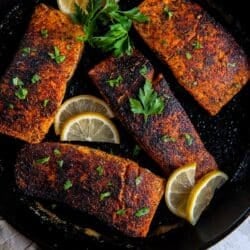This Baked Salmon in Foil recipe creates extremely moist and tender salmon with a lemony garlic butter sauce. It’s ready in under 30 minutes and cleanup is a breeze!
More salmon recipes we love include my Sockeye Salmon and Roasted Salmon with Maple Glaze.

Baking salmon in foil is the most fool-proof, simple method around for creating incredibly moist, melt-in-your-mouth fish. If you’ve had issues with your salmon ending up dry, you need to give this method a try.
In addition to being delicious, salmon is a great source of protein, healthy fats, and essential vitamins and minerals. It’s loaded with omega-3 fatty acids resulting in some great health benefits.

Introduce your little ones to salmon while they’re young and they’ll be fish lovers for life. From as far back as I can remember, I used to ask my mom to make for salmon for my birthday dinner. Kind of weird for a kid, I know, but her simply prepared, amazingly delicious salmon made me a fish lover from a very young age.
Table of contents
Ingredient Notes

- Whole salmon fillet – Also known as a side of salmon. You’ll find these great big fillets in different varieties including wild sockeye and Coho salmon and farmed Atlantic salmon. Costco always has a great selection of both including the wild sockeye fillet pictured in this post. See below for more details on the difference.
- For the Garlic Butter Sauce – Butter, minced garlic, honey, Dijon mustard, fresh lemon juice, and fine ground sea salt.
- Lemon slices – Grab an extra lemon or two to slice and serve with the salmon.
- Fresh herbs – I usually garnish the salmon with parsley but you can use a variety of other fresh herbs including dill, thyme or basil.
Wild Salmon vs. Farmed Salmon
When deciding between wild salmon or farm-raised salmon, there are some important things to keep in mind. Wild-caught salmon survive on a diet found in their natural environment which results in their darker pink hue. On the other hand, salmon raised in fish farms is fed a processed diet that is high in fat and protein in order to make them larger. This explains why farm-raised Atlantic salmon fillets can weigh between 2 to 3 pounds each. Wild fillets tend to run smaller and are a little more expensive but are better in flavor and many believe they are a better environmental choice.

How to Bake Salmon in Foil
This is a quick overview of how to make this recipe. You’ll find detailed instructions in the recipe card at the end of this post.

Lemon Garlic Butter Sauce
- Melt the butter in a small saucepan over low heat and add the minced garlic.
- and allow it to simmer for a minute or two until fragrant.
- Whisk in the honey, Dijon, juice of half a lemon, and the salt, until smooth.

Make the Foil Packet and Bake
- Place a piece of heavy-duty foil large enough to fully enclose your salmon on a rimmed baking sheet. Place the salmon on the foil .
- Spoon the slightly cooled garlic butter sauce over the top. Enclose the salmon completely in the foil, folding over the ends to seal in the sauce.
- Bake until the salmon appears almost completely cooked through at the thickest portion. Open the foil and spoon the sauce that has accumulated in the foil over the top. Press the foil down around the edges of the baking sheet and broil it briefly to finish cooking the salmon. Squeeze the juice from the remaining half of a lemon over the top and garnish the salmon with fresh herbs.
If using two smaller salmon fillets, wrap them in separate sheets of foil and place them next to each other on the baking sheet.
How to Know When Salmon is Done
The best way to test whether your salmon or any seafood or meat is fully cooked is to use a meat thermometer. The FDA recommends an internal temperature of 145 degrees F but most experienced cooks agree that this can result in dry salmon. For the best result, remove your salmon from the oven when the temperature of the thickest part of your salmon fillet reaches 135 degrees F to no more than 140 degrees F.

Serving Suggestions
Round out this meal simply prepared vegetables like asparagus or a tossed salad. The rice, potato, pasta, and vegetable dishes below are all great choices for serving with
- Almond Rice Pilaf
- Orzo with Peas and Parmesan
- Easy Parmesan Noodles
- Pesto Green Beans
- Crispy Oven Baked Fries
- Greek Potatoes
- California Coleslaw
It’s a rare thing for me to serve fish in this house without making Creamy Dill Sauce to serve along with it. It is the perfect complement to baked salmon.

More Seafood Recipes You’ll Love
- Blackened Mahi Mahi
- Orange Sesame Ginger Glazed Salmon
- Air Fryer Fish Sticks
- Shrimp and Spinach Pasta

Storage Tips
Promptly refrigerate leftover salmon in an airtight container. Leftover will last up to 3 to 4 days if packaged properly and stored in the refrigerator.
Leftover salmon can be gently warmed in the microwave or serve it cold in a salad.

Sign up for my free newsletter for all the latest recipes and join me on Facebook, Instagram and Pinterest for more cooking inspiration!

Baked Salmon in Foil
Ingredients
- 2 to 2 ½ pound whole salmon fillet (side of salmon)
- 4 tablespoons butter
- 1 teaspoon minced garlic
- 1 tablespoon honey,
- 1 tablespoon Dijon mustard
- ½ teaspoon fine ground sea salt
- freshly ground black pepper, to taste
- 2 lemons, halved and divided
- 1 tablespoon chopped fresh herbs, parsley, dill, thyme, or basil
Instructions
- Preheat oven to 400 F degrees.
- Melt the butter in a small saucepan over LOW heat. Add the minced garlic and allow it to simmer for a minute or two until fragrant. Whisk in the honey, Dijon, juice of half a lemon, and the salt, until smooth. Remove from the heat and allow the mixture to cool for 2 or 3 minutes.
- Place a sheet of heavy-duty foil large enough to fully enclose your salmon on a rimmed baking sheet. Place the salmon on the foil and spoon the slightly cooled garlic butter sauce over the top. Enclose the salmon completely in the foil, folding over the ends to seal in the sauce. If using 2 fillets, place them on separate sheets of foil, divide the sauce between them, and place them next to each other on the baking sheet.
- Transfer the baking sheet to the preheated oven and bake for 12 to 15 minutes, or until the salmon appears almost completely cooked through at the thickest portion.
- Remove the baking sheet from the oven and set the oven to BROIL. Open the foil and spoon the garlic butter sauce that has accumulated in the foil over the top. Press the foil down around the edges of the salmon so that the top of the fillet is completely exposed and return it to the oven for 2 to 3 minutes or until it reaches 135 degrees F to no more than 140 degrees F when tested with an instant read thermometer. The salmon should not brown, it will just finish cooking.
- Remove the baking sheet from the oven and squeeze the juice from the remaining half of a lemon over the top. Sprinkle the parsley over the salmon. Slice and serve with lemon wedges.
- Slice the remaining lemon into wedges and serve with the salmon.
Nutrition
Nutrition information is automatically calculated using generic ingredients, and is an estimate not a guarantee. For more accurate results, please refer to the labels on your ingredients at home.
This post was originally published on August 18, 2015. It has been updated with new text and images.




















